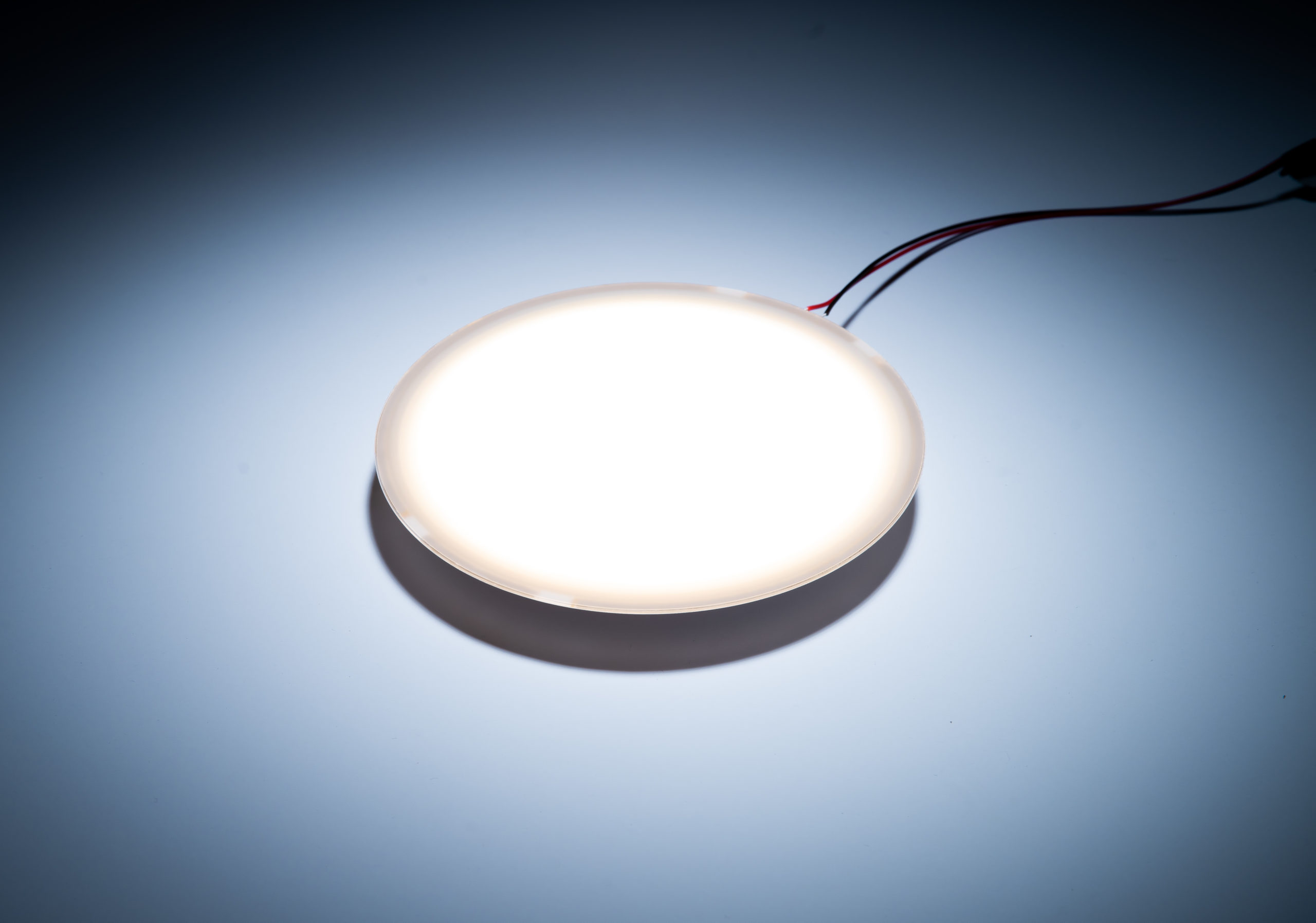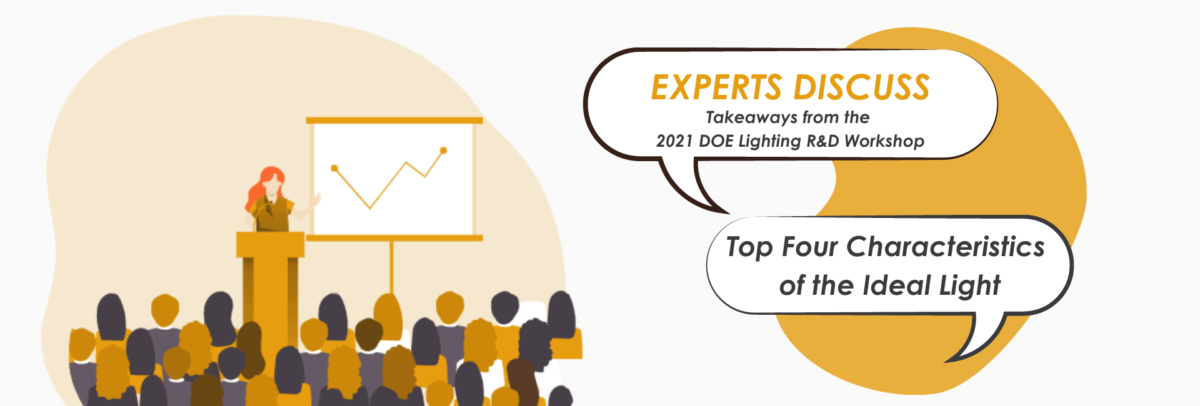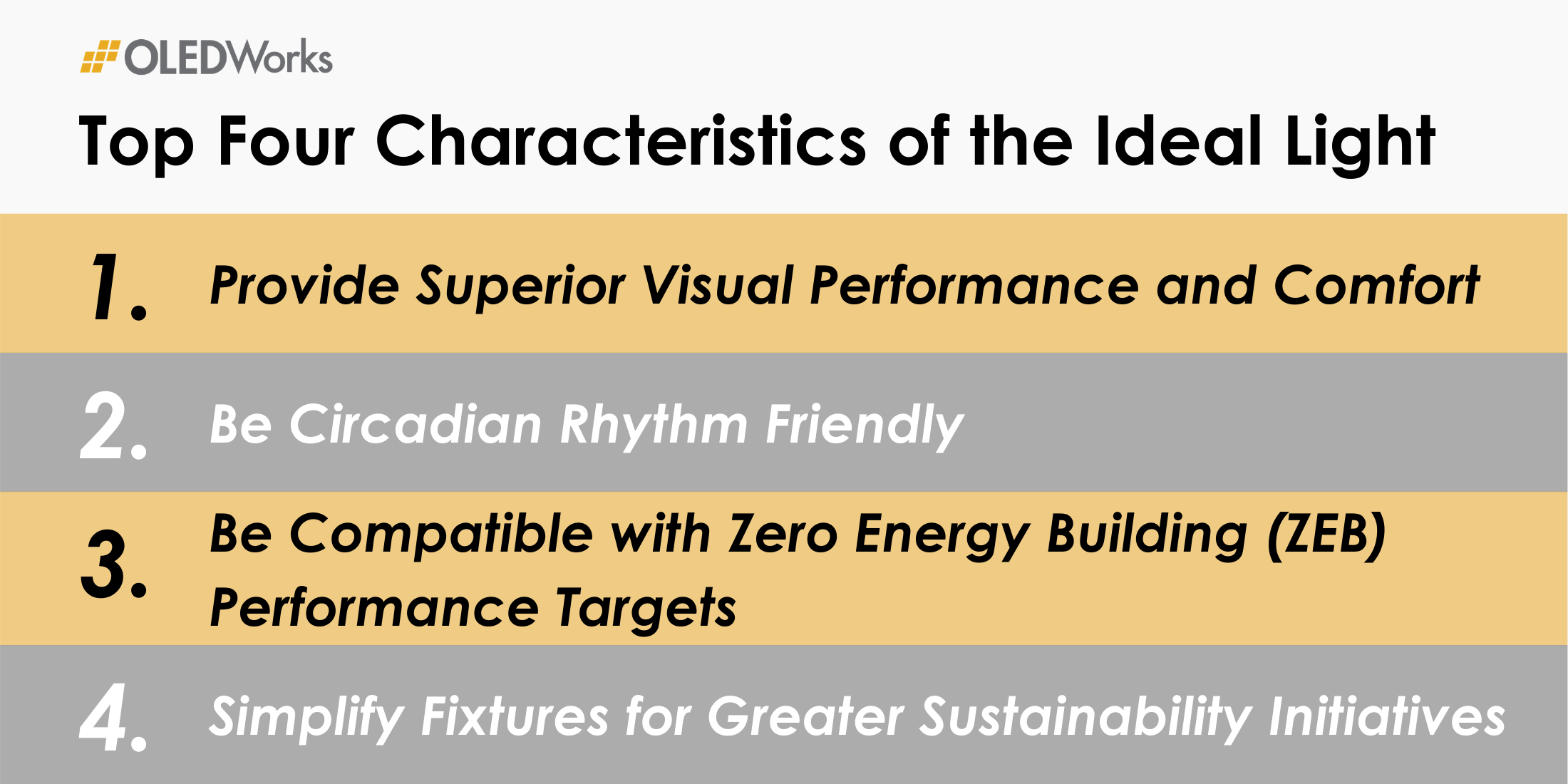
By Dr. Marina Kondakova, Director of Device Formulation
Recently I participated in the virtual 2021 Lighting R&D Workshop organized by the US Department of Energy (DOE). It was a very informative, well-organized conference where lighting experts shared their thoughts and findings on new lighting trends and research areas that will influence the future advancement of solid-state lighting (SSL) technology.
Current lighting trends are aimed at energy savings, the development of healthy light, automated lighting systems, and a transition to smaller, simpler luminaires and fixtures. With this in mind, several sessions were focused on trying to answer the question: what are the characteristics of the ideal light source for architectural lighting? How can they be achieved by lighting integration schemes and future lighting technologies?
According to the various lighting experts, an ideal light source for architectural lighting should exhibit the following key features.
Provide Superior Visual Performance and Comfort
Indoor lighting should enhance your environment by providing a comfortable lighting experience with high color quality. It is known that lighting can have a significant effect on people’s productivity, mood, alertness, circadian entrainment, and more.
As efficacy of SSL sources increases and their size decreases, it is crucial to maintain visual comfort. Use of optics as well as placement of the fixtures help achieve uniform emission and mitigate glare. The use of optics is particularly relevant for point sources as it allows light to be redirected to where is it needed or hide the light source from field of view, reducing discomfort and glare. In short, the ideal light source provides sufficient illumination for the user, while being able to be viewed comfortably from any angle.
One SSL option that offers superior visual performance and comfort is Organic Light Emitting Diodes (OLEDs). Made of organic layers deposited on glass, OLEDs are a naturally diffuse area light source, emitting uniform light that is soft and virtually glare-free. The high color-rendering capability of OLEDs also mean that the colors in your space will look the way that they are meant to, close to how they would appear under sunlight.
Be Circadian Rhythm Friendly
After two decades of research, there are no arguments about the fact that lighting can have a positive or negative effect on our mental and physical health. It is essential to have healthy lighting in the workplace, home, and other places where we spend a lot of time indoors.
It is known that exposure to bright daylight, even for as little as 30 minutes per day is beneficial for our health. It promotes energy, alertness, positive mood and better sleep. But access to daylight in the spaces we spend most of our time is not always available. In this case, the solution is artificial circadian lighting that can mimic the light/dark cycle of sunlight. The ideal indoor illumination is color-tunable, i.e. able to shift light intensity and color temperature based on the time of day, providing these same benefits we receive from natural light.
Additionally, circadian stationary luminaires and lamps can include variable optics that allow light to be redirected upward during the daytime and downward during evening, therefore changing the total amount of light the eye receives during a day. The ability to control this light level is critical for our health and wellbeing.
As a member of the SSL family, OLED lighting is a circadian-friendly option for spaces with limited access to daylight. Color-tunable OLED panels are currently being researched and developed specifically for this purpose.
Be Compatible with Zero Energy Building (ZEB) Performance Targets
The US DOE definition of a zero energy building (ZEB) is as follows: “An energy-efficient building where, on a source energy basis, the actual annual delivered energy is less than or equal to the on-site renewable exported energy.” Essentially, the building produces enough renewable energy to meet its own annual energy consumption.
There are a number of strategies to get to ZEB, and an efficient lighting system is one of them.
A light source that is highly energy efficient will require less energy to operate than traditional lighting technologies, meaning lower energy production is needed to offset lighting use. When this is combined with sensor-controlled automated lighting systems that will strategically turn lights off when rooms are unoccupied, lighting energy costs can decrease even further.
While daylighting provides health benefits and reduces energy cost, it has a number of disadvantages, such as high installation cost, need for glare control and undesirable heat gain inside the building.
Like LEDs, OLED luminaires are energy-efficient lighting systems that will reduce the amount of energy needed to operate compared to traditional lighting technologies. A unique benefit to OLEDs is that they operate at very low heat, which could reduce the cooling load on the building and lead to significant energy conservation. In addition, OLEDs are suitable for ZEB because they can easily be installed into existing buildings, as they require very little housing.
Simplify Fixtures for Greater Sustainability
SSL technology is already highly energy efficient, but the ideal light source will take sustainability one step further. As mentioned above, one of the current trends in lighting is to minimize the size of fixtures and luminaires and to remove unnecessary technical components.
Green lighting should consist of easy to assemble, easily reparable light sources, luminaires and fixtures made with sustainable, bio-friendly materials and components that can be efficiently recycled (i.e. disassembled at low cost and low labor) with no toxic byproducts. This trend of reducing materials used and increasing the recyclability of the total fixture parts will result in more environmentally friendly lighting products.
Simplicity of a lighting source’s form will also allow designers to easily integrate the light into various products, enhancing the features of their existing portfolio, and finding new applications for light.
OLED lighting is a simple but powerful lighting solution that does not require additional optical components such as light guided films or diffusors. This reduces the number of materials and components, saving money and time through a simpler fixture construction. With its thin profile, an OLED light can be used in various applications, expanding design capabilities. Composed almost entirely of glass and thin layers of organic materials, OLED panels offer efficient recyclability at end of life.

The thin profile of an OLED lighting panel (OLEDWorks Brite 3 Round)
With its unique performance capabilities, OLED lighting achieves all of the characteristics of the ideal light source discussed by these lighting experts. And with emerging advanced materials and manufacturing techniques, OLED performance continues to improve while its cost steadily decreases.
| References: | |
| What is Ideal Light? | Lighting the Future |
| Tero Mäkinen, LEDiL | Naomi Miller, Pacific Northwest National Laboratory |
| Jennifer Scheib, University of Colorado Boulder | Thomas Phoenix, CPL Architects and Engineers |
| Brad Koerner, Cima |




